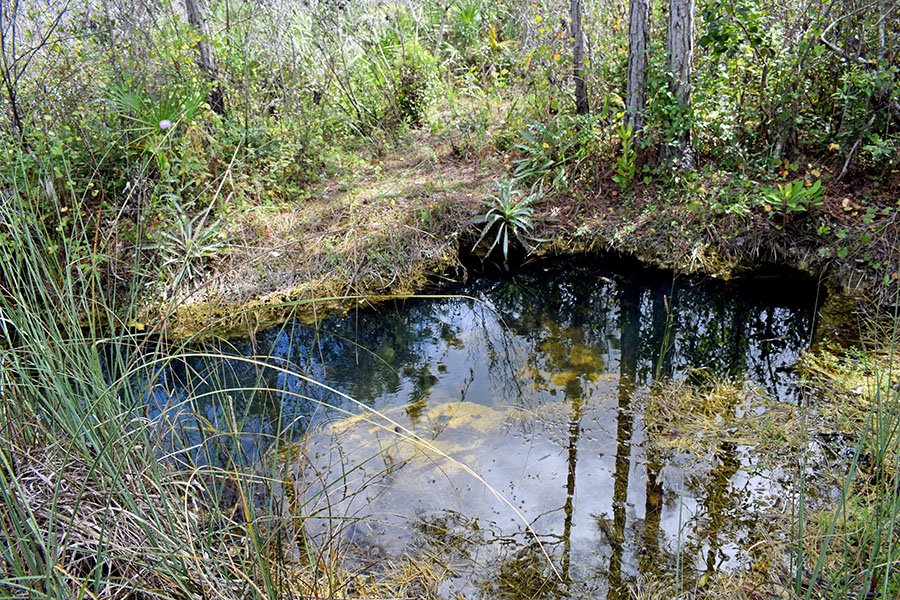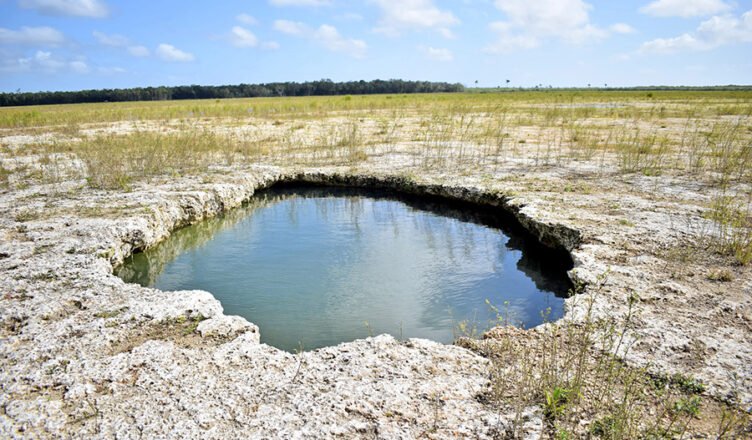Don’t freak out, but while you’re slamming vodkas in Brickell, acid is slowly eating through the very ground under your feet. It all started millions of years ago, and takes thousands of years, but the result are sink holes, solution holes, underwater caves, streams, and springs.
The process begins when rain water acidifies as it steeps in vegetation and has a chemical reaction with the limestone bedrock that we stand on. This rock dissolves, and when the holes reach into our shallow Biscayne Aquifer, the underground water surfaces in springs which can in fact be found in the heart of Miami (link to ancient well of mystery), and all the way in Everglades National Park.
Don’t believe me? Here’s what the National Park Service says, “”Springs in the Everglades are often seen as the water table rises during the wet season.”
Usually they are hidden deep in the wilderness, surrounded by trees and plants and interlocking roots and spears of an eye poking, foot stabbing nature. But thanks to a massive ecological restoration project in the “Hole In The Donut” section of the Everglades, their wonders are laid bare for all to see.
The “Hole In The Donut” lies between the famous Anhinga Trail and the Nike Missile Base close to the main road of the Flamingo entrance to Everglades National Park down south in Homestead.
Here is what a solution hole looks like with regular plant life around it.
 Here is what it looks like in the ecological restoration area.
Here is what it looks like in the ecological restoration area.

Until the 1970’s the “Hole In The Donut” was farmland, but the farmers couldn’t make a dollar out there and had to give up and leave. Over the 1980’s, and 90’s and 2000’s, the area was overtaken by the invasive scourge of plant life known as the Brazilian Pepper tree.
This gets much less attention than pythons, but invasive plants and trees do way more damage even faster than those slithering snakes.
But in recent years, a restoration decades in the making saw the “Hole In The Donut” scraped down to the limestone and cleared of all this invasive plant life with heavy metal machinery and hardcore labor.
As mammals, birds, and insects go about their business of eating and crapping, they’ll be planting seeds, dropping fertilizer, and pollinating flowers that will re-install native plant growth everywhere.
Some solution holes create the namesake springs, others connect to each other underground, and other simply form pools or ponds. At times they house alligators, cottonmouth snakes, various fish, and snapping turtles, especially when water levels are low. Currently water levels are at a historic high.
There are so many phenomenal examples of springs and solution holes just a stone’s throw from the roadway that I wrote a whole book about it and called it Hidden Springs of The Everglades. It’s a 109 page 8.5 x 11” book published by Katelevision that is full of interesting full color photographs, deeper explanations of the processes at work, and precise GPS waypoints for some of the most dramatic examples in the area. This is my tenth book in a series on the natural and cultural history of the greater Miami area and I hope you will check it out.
All photos ©Jacob Katel underwaterville.com


